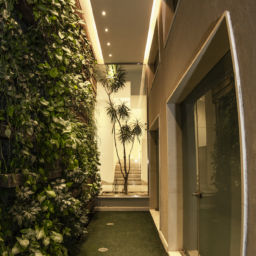
There is a great need to understand the future, and the future of landscape design is promising. Landscape architects are always playing a great role in designing landscapes, but with every update, they will have to be acknowledged with every new technique so that they get out the best they can. In this article, the effect of attaining sustainability in landscape will be discussed along with landscape’s effect on mental health and ending with the new technologies in designing landscape.
Sustainability in Landscape
There is always a problem in waste accumulation and its effect on the environment. That is why it’s crucial to use techniques in landscaping that reduce carbon footprint as well as it should be recyclable and eco-friendly. From these techniques are living walls and green roofs. Living walls and green roofs will help reduce carbon emissions as trees absorb carbon dioxide, which is a major greenhouse gas that contributes to global warming. In addition to that, they are watered through smart irrigation that allows the plants not to be overwatered or underwatered. This is important because that decreases water wasted, which adds to conserving water and energy. Not only smart irrigation contributes to the healthy environment, but also there is automated maintenance in outdoor spaces that conserves energy through sensors. These sensors maintain garden with precision, which avoids over or under trimming and this ensures plant health. As we look for a sustainable and a greener future, using renewable techniques will contribute to a healthier urban environment with the most minimal waste accumulation.
Landscape and Mental Health
Designing and implementing green spaces can improve mental health. Studies have shown that it reduces depression up to 19%. This means that many depressed people can get better due to green areas. This is a big hit because a lot of people are struggling with mental health problems, and with today’s life challenging problems, we need a solution to reduce stress and help in boosting people’s mood. Studies have also shown that when green spaces are implemented, this will enhance physical activity and social interaction, which also contribute to improving mental health. Furthermore, landscape architects themselves will need an escape from work, so why not to use their work as a stress reliever? Lastly, the experience of walking and enjoying nature increases the sense of connectedness and familiarity, which significantly improves well-being.
Landscape and AI
With the rapid development of technology, there are numerous industries that have been transformed by AI technology with no exception to the landscape design industry. Using the machine learning algorithms, landscape architects can analyze the data of the site they design for such as knowing the soil type, water retention, sun exposure, and weather changes so that they create special designs to this site accompanying its needs. AI can go further by analyzing the client’s data like what the client prefers in terms of design and color. This helps the designer to go in depth in knowing their clients more and satisfying their needs.
Landscape and VR
“Feeling the real world” is how VR makes clients feel. It’s called being “immersed” in the design. Landscape architects use VR to make a simulation of the real world so that they can edit and try special alternatives in the design before applying it in the real world. Clients can see and interact with design through the VR. This allows designers to indicate whether they used the right thing or not from clients’ interaction. This increases clients’ engagement with the designs as well as it helps in connecting both the designers and the clients, which further increases their satisfaction about the designs.
Conclusion
It’s important to address the topic about landscape designs and the future innovations so that we can be up to date to the technology. The future is everything as without the future, the present is useless. It’s essential to highlight the importance of sustainability in landscape designs and its role in mitigating climate change. Not to mention that mental health shouldn’t be a stigma anymore, and planning for making greener areas to improve mental health should be at the top of the list. All we need is a safe environment for our communities. Finally, innovations won’t stop and with the inclusion of AI and VR, creating landscape designs won’t be a big deal to improve clients’ satisfaction. By embracing these trends, our landscape architects will help promote a more sustainable and resilient future for us.
We will be thrilled if you contacted us if you need a landscape architect to help you on a new project. You can also check some of our previous projects here.














